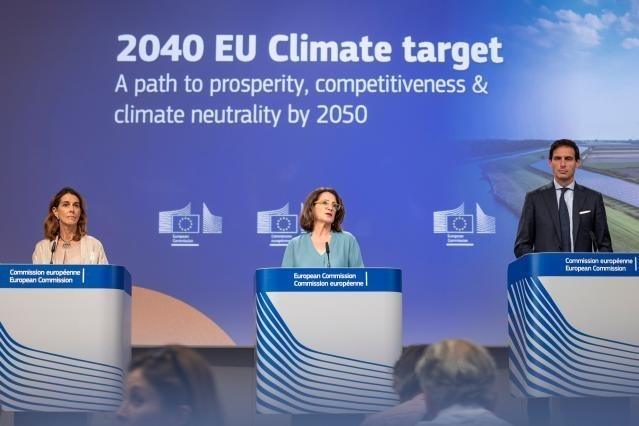The European Commission announced today a new proposed climate target, aiming to reduce net greenhouse gas (GHG) emissions across the EU by 90% by 2040, compared to 1990 levels.
The new target introduces several key proposed changes from the EU’s current goals, including the ability to utilize international carbon credits to achieve a portion of the 2040 target, and for carbon-intensive industries in the scope of the EU Emissions Trading System (EU ETS) to use domestic carbon removals for allowances to compensate for residual emissions from hard to abate sectors.
The Commission said that the proposal marked a “more pragmatic and flexible way to reach the target,” and noted that it took into account “the current economic, security and geopolitical landscape.”
European Commission President Ursula von der Leyen said:
“As European citizens increasingly feel the impact of climate change, they expect Europe to act. Industry and investors look to us to set a predictable direction of travel. Today we show that we stand firmly by our commitment to decarbonise European economy by 2050. The goal is clear, the journey is pragmatic and realistic.”
The new proposal would amend the EU Climate Law, initially adopted in 2021, setting into legislation the EU goal to reach climate neutrality by 2050. In addition to the 2050 goal, the 2021 law also set a binding EU climate goal to reduce net GHG by at least 55% by 2030 compared to 1990.
Following the adoption of the Climate Law, the Commission launched its “Fit for 55” initiative, introducing a broad series of legislation aimed at supporting the interim climate goal, including expanding its Emissions Trading System, introducing a carbon import tax, and setting emissions reduction targets and initiatives for key carbon-intensive industries. The Commission said that a future agreed 2040 target will serve as a benchmark for post-2030 climate and energy legislation.
In a recent update, the Commission reported that the EU is nearly on track to hit its 2030 climate goal, and noted that it has already achieved a GHG emissions reduction of 37% as of the end of 2023 on a 1990 basis, despite 68% economic growth over the same period.
The Commission communicated early last year its recommendation to set a 90% GHG reduction target for 2040. At the time, the Commission outlined its initial estimates for investments that would be needed to achieve the new 2040 target, including an estimated average annual investment of approximately €660 billion from 2031 – 2050 in the energy system, and €870 billion per year in the transport sector. Key areas of investment would target the decarbonization of industrial processes, improvements in energy efficiency in energy-intensive industries, a shift towards electrification, and the production of sustainable alternative fuels to power the transport sector.
With the introduction of its new proposal, the Commission outlined a series of actions and policies it has initiated to help enable the needed capital flows and simplify compliance requirements for companies, including the recent adoption of its new Clean Industrial Deal State Aid Framework (CISAF), and proposed adjustments to the carbon border adjustment mechanism (CBAM), the EU’s carbon tax on imported goods, which would exempt 90% of importers – primarily smaller businesses – from the CBAM rules.
Additionally, alongside today’s proposal, the Commission also issued recommended tax incentives, including accelerated depreciation and tax credits, aimed at encouraging investments in clean technologies and industrial decarbonization.
Among the key changes from the EU’s prior climate targets, the new proposed 2040 goal introduces the ability to use various forms of carbon credits to reach the target. Specifically, the Commission’s proposal would allow international carbon credits under Article 6 of the Paris Agreement to be used from 2036 to contribute up to 3% of the 2040 target. Additionally, the use of domestic permanent carbon removals through technologies such as Biogenic emissions Capture with Carbon Storage (BioCCS) and Direct Air Capture with Carbon Storage (DACCS) would be introduced into the EU ETS. The Commission pointed out that the use of carbon removals would help resolve one of its key climate challenges, by helping the land sector address its difficult to abate emissions by compensating through overachievements in sectors such as waste and transport.
The introduction of carbon credits into the EU’s climate strategy is controversial, with environmental groups warning that it would water down the EU’s emissions reduction ambitions. The WWF, for example, has warned that “relying on international offsets could divert resources from transforming the EU’s own economy—including investments in clean infrastructure, skills, and innovation,” and Greenpeace referred to the proposal as “dodgy accounting and offshore carbon laundering.”
Other sustainability groups, however, supported the changes, with climate consultancy South Pole CEO Daniel Klier calling the proposal “a pivotal moment for global carbon markets,” that could “channel much-needed finance to climate-vulnerable countries and support low-carbon sectoral transformations.”
Teresa Ribera, EU Commission Executive Vice-President for Clean, Just and Competitive Transition, said:
“We are not choosing between the economy and the green agenda, we are choosing both. Europe reaffirms its commitment to a fair, ambitious, and competitive green transition.”
The Commission’s proposed 2040 target will now be submitted to the EU Parliament and Council for discussion and adoption.

